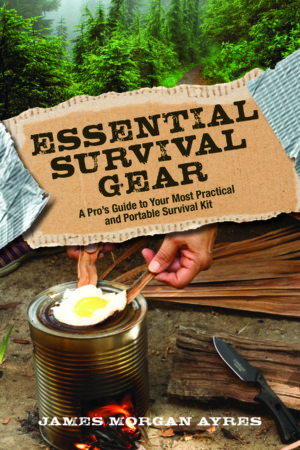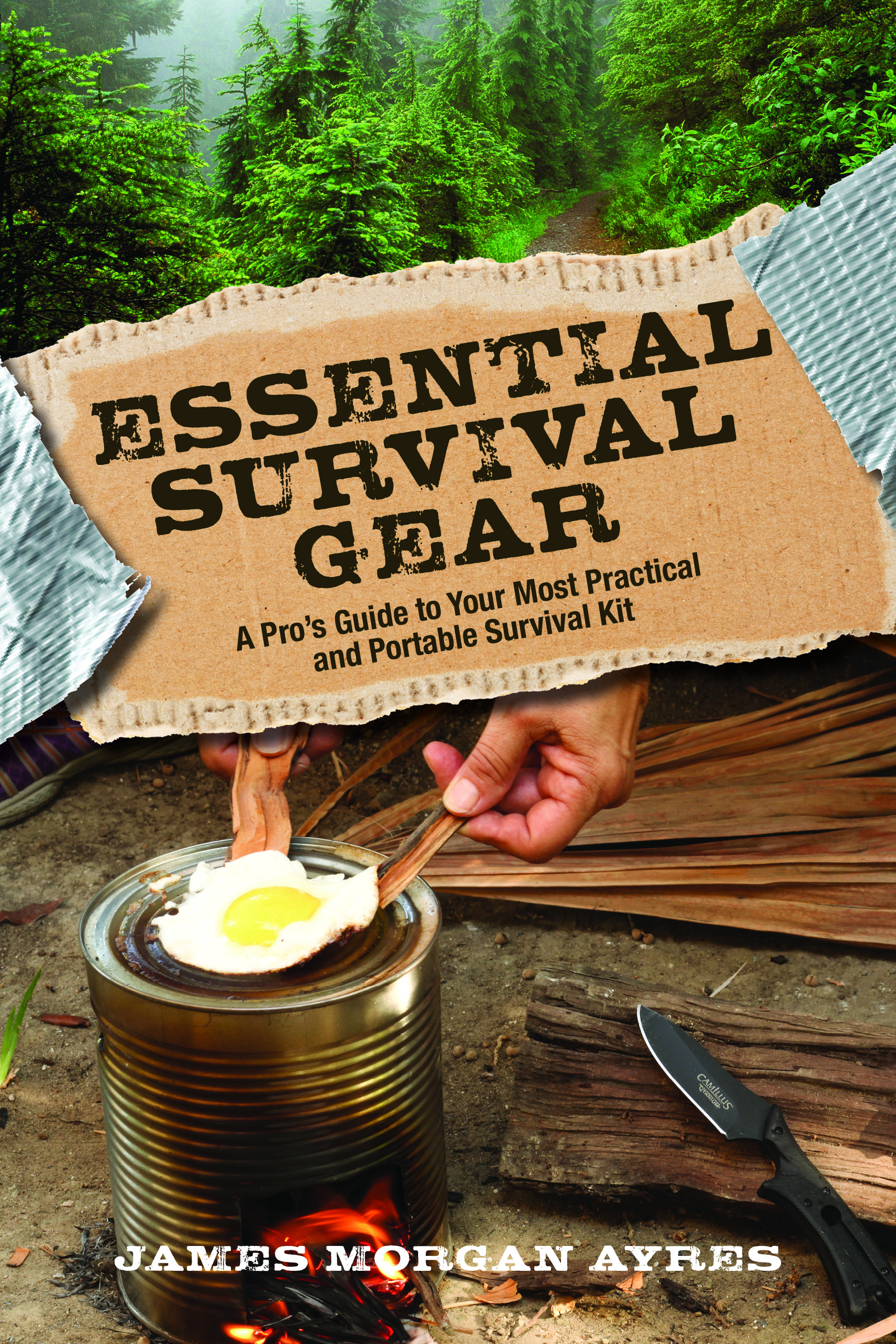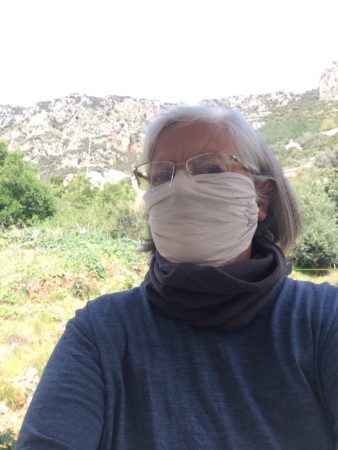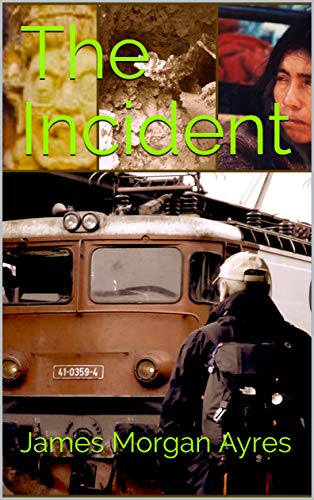The current Covid-19 pandemic has caused many to panic, which is the root word of pandemic, and to clean the shelves at supermarkets of everything from caned beans to TP. Panic is a nonfunctional response to any situation. More on that in The Tao of Survival excerpts I will continue to post. Such panicked buying and hoarding is an overreaction and puts more strain on systems that are already stressed. Get or have what you need and try to refrain from panicked hoarding.

Here is an excerpt from Essential Survival Gear that provides advice that many have found useful. In this book I detail the “layered system” of equipment, supplies and tools that I have used during decades of living through epidemics in 3rd Word Countries, riots and civil disorder and in low intensity war zones.
Base Camp, Base Camp Equipment
A base camp is any permanent (as much as anything is permanent in this ever changing world) or semi-permanent location that provides supplies, shelter, and communications, for persons engaged in wide-ranging activities. A base camp can be an encampment with trucks and wall tents, a large tarp or cave that shelters a mountain of supplies you’ve carried into the wilderness over footpaths, a log cabin, a sailboat, a holiday apartment or villa, or just about anyplace you might call home.
Base camp for most people reading this book is likely a house in the suburbs or a rural area or an apartment in the city. Unless, that is, the person who’s reading this book is doing so after the apocalyptic collapse of civilization as we know it. In which case the person who is holding this book might not actually be able to read English, or any other language. If that’s who has this book in hand, and if you can read the language in which it’s printed, I hope you do a better job of keeping things together than we did. If, as I hope, a member of our current civilization is reading this book let’s continue. There is some important information in these pages. If you’re a survivor of total collapse the part about credit cards may not apply.
What is essential gear for a base camp? Well, limited only by budget you can give yourself up to total consumer frenzy and anxiety, max out your credit cards, wear out your ATM cards, blow through your bank accounts, and pile up a year’s supply of MREs in the garage, equip everyone in the family with automatic weapons and stock up on enough ammo for a fire team in a war zone, buy body armor and zombie killer swords, trade in your minivan for a Hummer, buy a chemical toilet in case the water stops running, a gasoline powered electrical generator for when the power goes out, and sandbag the walls to stop incoming fire. You can do all that. America is, after all, the consumer society. And, ‘prepper fever’ is in the air. But there’s no reason to do so, unless buying all that stuff is your idea of fun, and three reasons to not do so.
First, you don’t need that level of defense or weaponry. Trying to turn your home into an armed bunker is a really bad idea. Doing so fosters paranoia, and it’s useless in any event. From what are you preparing to defend, an armed military force? Have you ever seen a military unit on assault? If that’s what you’re thinking, forget about it. Soldiers return fire. If you fire on a military unit they will reduce your house to debris and you and your family… Just don’t do that. If you want to be able to defend your home from civil disturbance or criminals, locked doors, a low profile, and a firearm in reserve, if you are well trained and have the judgment to use it – or NOT to use it – is enough.
Second, there are simpler solutions for other problems. Instead of buying an expensive (probably never to be used) chemical toilet, in case your water is shut off and toilets won’t flush, or if the pipes freeze and burst (as they once did in a cabin we had rented) put a plastic trash bag in the commode and dispose of it after use. A gas powered electrical generator is expensive, loud, polluting and requires a large fuel reserve. Storing fifty-gallon drums of gas (petrol) in your garage is a fire hazard, probably illegal and another really bad idea. If the power goes out, use candles and oil lamps for light. You can survive without the television. Trust me on this. For entertainment you can read by candlelight, converse with your family and neighbors, play games, and so on. If your frozen food might spoil, cook it or dry it, which is easy to do – instructions elsewhere. If the heat goes off, bring out the quilts and warm clothing.
In today’s consumer society there’s always someone trying to sell you something to solve some kind of problem, often a manufactured problem designed to sell goods. Resist. Self-reliance and creative thinking will save the day when stuff will not.
Third, you might have to evacuate and leave all that stuff behind.
Having some survival-oriented equipment (and plans) is useful and prudent. If you live in an earthquake zone, a wrench to turn off the gas if the main is ruptured during an earthquake is inexpensive and a good thing to have. You’ll have basic first aid medical equipment, including bandages, antibiotic ointment, face masks and disposable gloves, more on that below. You’ll watch the weather and be ready to go, or to button up, if you live in a hurricane area. If you might have to evacuate by auto or truck due to hurricane or wildfire, having some food and water, valuables, and a few family keepsakes ready to go is prudent. Of course each family member will have already have his or her ready bag and rucksack, which was detailed in Second Level Gear.
If you live in a tornado zone, you’ll have a storm cellar, or know where the nearest one is. I grew up in ‘tornado alley’ and lived through many twisters. After the twister passed, folks came out of their cellars and started repairing the damage, each helping the other as needed. If you live on a flood plain you might want to have a boat in the garage, or on top of it, or at least have a plan to get to higher ground. Once in Bali our rented holiday house was flooded by days of torrential rain. No one panicked, us or the neighbors. As the water rose we moved to the second floor. From windows we saw neighbors in small boats rowing along flooded streets and taking others who didn’t have upper floors to places that did. Eventually the rain stopped and the flood receded. People came out in the street, laughing, smiling, glad to see one another, and another day. That night, after spending the day cleaning up, we had a block party.
A portable camp stove of some kind (one you can take with you if you have to leave) with a small supply of fuel will enable cooking when the power and gas are out. Having a sufficient supply of quilts, blankets or sleeping bags for everyone in the house is sensible, especially if you live in a area that has actual seasons. Large reflective tarps, essentially space blankets, if strung above a roof and/or in front of windows will lower inside temperatures as much as twenty degrees, which can be critical if you live in a desert area and the power, thus the air conditioning, goes off. A couple of heavy duty tarps for the roof in case of rain damage, and rope to secure them, plastic sheeting for broken windows, duct tape, basic tools for repairs, warm quilts and blankets in case the heat goes out, oil lamps and candles in case of power failure, that kind of stuff is useful.
People the world over solve problems caused by disaster without expensive, specialized, equipment. More importantly, most people most of the time come together in emergencies and help one another. It’s what humans have been doing since we got started. Community is an essential survival tool, more on this topic in The Tao of Survival.
Food
You don’t have to be a ‘prepper’ or a ‘survivalist’ to keep on hand food and supplies for more than a few days. It’s simple prudence to have a supply of food and water stored at your home, and it certainly is not necessary to rely on MREs or specialized ‘survival rations.’ Folks I know in every culture I’ve spent time in that has retained any of its traditional roots keep a supply of food on hand. They use it daily and resupply as needed.
Our American friends who live in a small house in the far north of Japan have on hand at any time a large quantity of dried seafood: fish, shrimp, squid, octopus, abalone, and various sea vegetables. They also have a freezer full of seafood, chicken, pork and vegetables. If the power goes out and the frozen food starts to thaw they can dry or cook those supplies before they spoil. From Costco, which in Japan delivers, they buy rice in ten kilo bags, wheat and rice noodles in large cartons, gallon jugs of saki, wine, soy and fish sauce, and so on. They use all of this in daily cooking, eat very well, enjoy doing so, and resupply as needed.
When I lived in a village in Mexico the local people always had on hand large bags of pinto or black beans, and rice, and masa (cornmeal for tortillas) and bins of different kinds of dried corn to be ground for masa or used in soups, and thin foot wide slabs of dried beef, and various dried vegetables. They kept a few chickens and turkeys. Prickly pear cactus, which is very tasty, grew all around their house. They had their own well.
Our friends in the Le Marche region of Italy buy in bulk and will typically have on hand ten-kilo bags of rice and wheat flour, ten kilo bags of white and lima beans, and large cartons of pasta, There’s always at least one whole prochutto (dried ham) and various dry salamis and sausages, a large wheel of dry romano or parmesan cheese, a large tub of olives, strings of garlic, bins of potatoes, carrots, turnips, onions, apples, large cans of tomatoes, and five-liter jugs of olive oil. In season they sun dry tomatoes and eggplants and store them in jars of olive oil. Ten-liter straw sheathed green glass jugs of red and white wine come from the local co-op. They eat the produce of their garden in season and pick wild greens from the hillside. They keep a dozen chickens for eggs. Their neighbors keep rabbits for meat and they trade eggs for rabbit. In autumn they might take one of the wild boars that ravage their garden from time to time.
With variations in local food this kind of practice is common over most of the world. In France, in addition to flour and other staples, it’s pates and terrines of goose, duck, and pork, which keep for months. One of our friends who lives in a Bulgarian village keeps a hundred liter wooden barrel filled with cabbages and other pickled vegetable in brine, shelves of home canned vegetables, another barrel of goat cheeses, jars of brined pork, smoke cured hams and wine he made from his own grapes. He has a goat for milk. Our neighbors in Turkey dry all kinds of fruit and vegetables on white sheets spread under the sun. This produce is stored along with goat cheese, large bags of bulgar, rice, and two or three kinds of beans and lentils. They also have chickens and goats.
None of these people are wealthy. But as a matter of tradition they keep a season’s food on hand. From these traditional supplies, supplemented with fresh food, they prepare delicious and healthy meals. Allowing for differences in culture and foodstuffs, this is pretty much how my grandparents lived. Yours might also have. Although the America of today is very different than that of our grandparents, it’s not a bad idea to bring back some of their practices.
Even city apartments have space to store dry and canned foodstuffs. Suburban houses usually have plenty of space for a vegetable garden. Some apartments do too. In our travels we see many window boxes on balconies of city apartments producing various vegetables. Unfortunately, many places in America have zoning laws that prohibit vegetable gardens and chickens and goats. Some citizen action could change that. Well, maybe not the chickens and goats. But I doubt anyone could make a strong case that daffodils are inherently more virtuous that tomatoes. Meanwhile, I know of no law that prevents anyone from storing a prudent supply of food at home.
During the years we were raising a family and maintaining a home in a large city we always had on hand a supply of staples that lasted for a month or so, and two to three weeks of bottled water. When we all (ML and I, three sons and a cat) lived aboard and cruised on our sailboat we stored at least two months of supplies, including three or four cases of wine – no need to suffer – and fished off the back of the boat. These days we travel much of the time, lightly loaded as previously described. When we arrive at one of our base camps the first thing we do is stock up on non-perishable food and bottled water. Buying in bulk and storing food is economical and makes good survival sense.
Water &Water Treatment
Unfortunately, in much of the world, including parts of the United States, tap water is not safe to drink. Industrial and agricultural pollutants are carcinogenic, long-term hazards. Lead from old pipes is also a long-term hazard, one that’s been eliminated in many, but not all, cities. Bacteria, prevalent in lesser developed nations but not as common in the U.S., poses short term threats, possibly fatal.
Bacteria can be killed by various chemical treatments, or eliminated by filtering. Detailed information on chemical treatment of large supplies of water has been worked out by specialists, and is available free of charge from the appropriate government agency.
As with rucksack-sized filters, only filters for your tap water that use activated charcoal can remove industrial and some agricultural pollutants. Some agricultural pollutants can only be removed by distillation, or by processes requiring sophisticated technology. Some cities use these processes. Others do not.
Having your tap water tested is inexpensive and a worthwhile protective measure for your family. If unsure of your water quality, adding a filtration system to your tap, or otherwise filtering it, provides a good level of protection, and might be less expensive that bottled water.
Storing and rotating bottled water from a trusted source is a relatively inexpensive safety measure, and could prove critical in an emergency. I’ve made it a practice to store at least week’s supply of bottled water for each person in the household wherever we are.
Medical Supplies
If you know how to use medical supplies you know what you need. If you don’t know how to use medical supplies, it’s a good idea to get some basic medical training, which is available from your local Red Cross and other agencies. Dispensing medical information or advice is outside the parameters of this book. I will suggest, however, that the companies whose products I use provide excellent quality medical supplies the include everything from major wound management supplies to protective equipment for use in epidemics and toxic exposure.
My previous post on masks covered that topic. I won’t repeat it here.
Since your forth level of survival gear is your base camp, you might as well make it feel like home, rather than a bunker.

 Sun, Apr 5, 2020: Killing Mr. Jones
Sun, Apr 5, 2020: Killing Mr. Jones Wed, Apr 1, 2020: On Hoarding
Wed, Apr 1, 2020: On Hoarding Mon, Mar 30, 2020: Masks Save Lives – Covid-19
Mon, Mar 30, 2020: Masks Save Lives – Covid-19 Sun, Mar 29, 2020: Visions of Apocalypse
Sun, Mar 29, 2020: Visions of Apocalypse Fri, Aug 23, 2019: Hijacked Twitter
Fri, Aug 23, 2019: Hijacked Twitter Sun, Aug 18, 2019: The Incident
Sun, Aug 18, 2019: The Incident Sat, Aug 10, 2019: Seas and Oceans Without End
Sat, Aug 10, 2019: Seas and Oceans Without End
Great excerpt from an excellent book! Time to find it on my Kindle and read it again..,